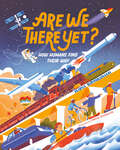Title search results
Showing 1 - 3 of 3 items

Are We There Yet?: How Humans Find Their Way (Orca Timeline #4)
By Maria Birmingham, Drew Shannon. 2023
DAISY audio (Direct to player), DAISY audio (Zip)
Adventure and exploration, Social issues, Politics and government, General non-fiction, Travel and geography
Human-narrated audio
Part of the nonfiction Orca Timeline series for middle-grade readers, this illustrated book examines how humans have navigated the world over time.

Hello, Dark
By Tamara Campeau, Wai Wong. 2021
Printbraille
General fiction, Alphabet, number and picture booksGeneral non-fiction, Social issues, Self help, Health and medicine
Human-transcribed braille
A child overcomes his fear of the dark by imagining it as a shadowy friend to play with and by recognizing it as a necessary force of nature
Available copies:
0

Are We There Yet?: How Humans Find Their Way (Orca Timeline #4)
By Maria Birmingham. 2023
Braille (Contracted), Electronic braille (Contracted), DAISY Audio (Direct to Player), DAISY Audio (Zip), DAISY text (Direct to player), DAISY text (Zip), Word (Zip), ePub (Zip)
Adventure and exploration, Travel and geography, General non-fiction
Synthetic audio, Automated braille
Why do some people have a bad sense of direction? How can you avoid getting lost? Why did early mapmakers…
put fake towns on their maps and why does every traffic controller in the world speak English? From finding food, water and shelter to traveling for commerce, trade and eventually exploring the world, humans have always had to find their way from one place to another. Are We There Yet? examines the evolution of how we navigate the world. Our earliest ancestors relied on built-in navigation systems in our brains and followed clues like star patterns and animal behavior. Then came the invention of maps, faster transportation and eventually technology, like satellites and GPS. And from the depths of the ocean to faraway planets, there's still plenty of exploring to do. Where will we go next? The epub edition of this title is fully accessible.